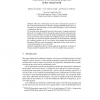Free Online Productivity Tools
i2Speak
i2Symbol
i2OCR
iTex2Img
iWeb2Print
iWeb2Shot
i2Type
iPdf2Split
iPdf2Merge
i2Bopomofo
i2Arabic
i2Style
i2Image
i2PDF
iLatex2Rtf
Sci2ools
ECCV
2008
Springer
2008
Springer
Calibration from Statistical Properties of the Visual World
What does a blind entity need in order to determine the geometry of the set of photocells that it carries through a changing lightfield? In this paper, we show that very crude knowledge of some statistical properties of the environment is sufficient for this task. We show that some dissimilarity measures between pairs of signals produced by photocells are strongly related to the angular separation between the photocells. Based on real-world data, we model this relation quantitatively, using dissimilarity measures based on the correlation and conditional entropy. We show that this model allows to estimate the angular separation from the dissimilarity. Although the resulting estimators are not very accurate, they maintain their performance throughout different visual environments, suggesting that the model encodes a very general property of our visual world. Finally, leveraging this method to estimate angles from signal pairs, we show how distance geometry techniques allow to recover the...
Angular Separation | Blind Entity Need | Complete Sensor Geometry | Computer Vision | Dissimilarity Measures | Distance Geometry Techniques | ECCV 2008 |
| Added | 15 Oct 2009 |
| Updated | 15 Oct 2009 |
| Type | Conference |
| Year | 2008 |
| Where | ECCV |
| Authors | Etienne Grossmann, José António Gaspar, Francesco Orabona |
Comments (0)

